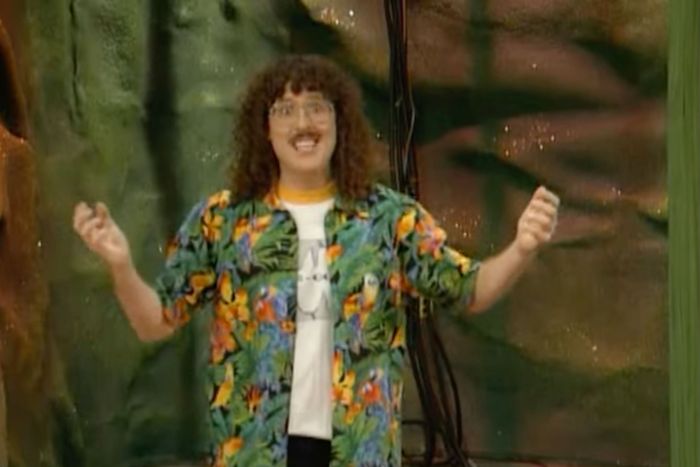
“Weird Al” Yankovic is tenacious.
It took him 32 years to reach the end of the record contract he signed in 1982, but he saw it through with the release of his 14th album, 2014’s Mandatory Fun. And when Sony refused to give him a budget for any music videos, Yankovic knocked on the doors of Yahoo, Nerdist, Funny or Die, and several other websites who once made original video content and got them to create videos with him. It took some work, but Mandatory Fun blew the doors off the industry, becoming Yankovic’s first No. 1 album and the first comedy album to top the charts since 1963.
He worked even harder to make his children’s show happen. Yankovic and his manager, Jay Levy, pitched Weird Al’s journey into Saturday morning television as early as 1984, though The Weird Al Show wouldn’t air on CBS until 1997. Yankovic butted heads with the network for years until he got an unlikely assist from Bill Clinton’s FCC. The Children’s Television Act went into effect in 1997 and required all broadcast stations to program at least three hours a week of educational programming targeting kids age 16 and under. “We were just about to get the thumbs-up in the meeting, and they had the caveat: ‘Oh, you know what? … We have to have a certain number of educational children’s shows. That’s really all we’re looking for right now.’ So I said, ‘We’re an educational show!’” Yankovic said in a 2017 interview with Rolling Stone while recalling his pitch to CBS. “We weren’t … but that was the deal we made with the devil in order to get it on the air.” This would not be the end of disagreement between Yankovic and the network over what kind of show they wanted to create: a live-action sketch show, an animated series, a musical performance showcase? (It would be all three.) The Weird Al Show’s life was short, lasting just 13 episodes, but remained enough of a cult hit for a DVD release ten years later featuring an informative commentary track, in which Yankovic and his collaborators frankly discuss the sometimes difficult creation of the show.
Despite the hurdles, Yankovic and his production team recruited an incredible roster of talent to bring the show to Saturday mornings. Comedians like Eddie Gorodetsky and Bob Odenkirk came onboard for early brainstorming sessions; the latter was called by a harried Yankovic in the middle of the night asking him to name a pair of puppets voiced by comedy legend Stan Freberg and son Donavan Freberg. The names Odenkirk spat out after a moment’s thought were Papa Boulie and Baby Boulie, inexplicably. Yankovic was head writer, and his writers’ room included luminaries like Ron Weiner, whose résumé would later add 30 Rock, Arrested Development, and Futurama, among many others; Zeke Kamm, who would stay in children’s television with My Life As a Teenage Robot, Whatever Happened to … Robot Jones?, and other non-robot shows; and Tracy Berna, who would also continue writing in animation. Even the writers who didn’t get hired were incredibly talented: The show considered but did not hire Mo Rocca, Will Forte, and Seth MacFarlane, who pitched characters that would eventually turn up in Family Guy. Director Peyton Reed shot all 13 episodes of the show years before going on to direct 2000’s Bring It On and Marvel’s Ant-Man films. On the commentary track for the second episode, “Promises, Promises,” he’s asked if there are any lessons he learned that he took with him to his film career, and he replies, “Shoot it fast!”
When The Weird Al Show debuted in 1997, it hit the ground running with Yankovic’s particular brand of silliness. The opening minute of each episode is probably the most enduring element of the show, with an over-the-top theme song married with animation from three different studios. The track would eventually appear on Yankovic’s 1999 album Running With Scissors.
The incredibly catchy theme song’s convoluted story is told in three distinct animation styles: cel animation, early CG, and stop-motion. There are numerous references to Yankovic’s earlier works in the lyrics, such as him working in a nasal decongestant factory, spatulas, and playing on a company bowling team. There were also references in the animation itself; the stop-motion portion was done by Scott Nordlund and Mark Osborne, who had previously animated Al’s “Jurassic Park” video in 1993.
Following the theme song, each episode began with a CBS-mandated lesson that hit viewers over the head with the ham-fisted moral they were going to “learn” by the episode’s end. Often the episode’s moral and story worked perfectly together, such as the moral of episode 11, “The Competition”: “It is always important to play fair.” Other times they were much more obtuse, such as the moral of episode 4, “Back to School”: “Learning new things takes time, study, and hard work,” which in 2017 Yankovic summarized as, “You should try to learn, but don’t try to learn too much.” The show’s narrator, Billy West, was instructed to read the morals in a nonsensical way by shouting clauses from the sentences at random. Reed had each episode begin with the moral written on parchment, only to be ripped in half and discarded to the floor as the camera pushes forward.
The show had a few recurring segments, but perhaps the best expression of what The Weird Al Show could have been comes through in the “Channel Hopping” segments. Similar to Late Night With Conan O’Brien’s “Satellite TV” desk bits, Yankovic sits down at his TV and flips through the channels, allowing him to parody television in the manner you might expect from his music career.
This element of the show required no education or pontificating; Yankovic could just be silly — like in this Bill Nye parody, which actively teaches children nothing.
Fred Huggins clearly owes some inspiration to Fred Rogers, but Yankovic also cited Captain Kangaroo and 1970s magician Doug Henning. The aforementioned Stan and Donavan Freberg voice and puppet Huggins’s sidekicks, bringing Stan’s career full circle from his start as the voice and arm behind Cecil the sea monster on Time From Beany, from the golden age of television.
The DVD commentary track also features Yankovic and Reed reenacting a Huggins segment that CBS’s censors shot down for pretty obvious reasons.
Commercials were also frequent targets on The Weird Al Show, like this incredibly specific parody of the “Got Milk” campaign. This segment and the other “Channel Hopping” segments all featured an overlay of a TV screen to prevent children watching from thinking they were watching actual commercials, but for some reason this parody of 1990s-style toy marketing was allowed to air without any such restrictions.
Initially CBS wanted Yankovic to feature his existing songs on the show, but their refusal to pay royalties for the original songs that were being parodied stymied that plan. His parody of the Kinks’ “Lola,” entitled “Yoda” from 1985’s Dare to Be Stupid, is the lone performance from Yankovic and his band of an existing Weird Al song.
The only original parody song Yankovic wrote for The Weird Al Show is perhaps the strangest choice for an audience of children on Saturday morning. The music video for Prodigy’s repetitive, electronic 1997 hit “Firestarter” featured singer Keith Flint dancing and gesticulating wildly, sporting his trademark haircut of a horseshoe-shaped, colored horn of hair surrounding a partially shaved dome. That same year, Yankovic took this look and ran with it for 30 seconds with his song “Lousy Haircut.”
There were also occasional non–Weird Al musical performances, including the national television debut of the Barenaked Ladies. The band nearly backed out after being forced to dress in medieval costumes for a throwaway gag and the production having to film their introduction twice: one regular version, and one in case the show wasn’t allowed to say the name of the band on a children’s show. In spite of the setbacks, BNL was properly introduced as they performed “Shoebox” at the end of The Weird Al Show’s first aired episode:
In a major coup of a booking for a children’s TV show in 1997, Yankovic also managed to get Hanson on the show. The trio was just beginning to promote the follow-up single to their massive hit “MMMBop,” “Where’s the Love.”
Each episode featured a main story that these and other segments would interrupt, and oftentimes these stories allowed Yankovic to reach out to celebrities to see if they would be interested in a guest appearance. In some cases, Yankovic had to get more creative and describes on the DVD commentary trying approaches such as attending several performances of Jeff Goldblum’s jazz band to see if he would appear on the show (he would not) or strolling through the studio of his show’s next-door neighbor, The Tonight Show With Jay Leno, to see if any of Jay’s guests could do Al a favor (this was how Al scored a ten second Drew Carey cameo).
Guests who did appear on the show include the always wonderful Terri Garr, who arrives on set to play jai alai with Yankovic, but accidentally ends up in the midst of a time-travel plot.
Macho Man Randy Savage literally burst through a wall to distract Yankovic from the robbery of his cave and to challenge Harvey the Wonder Hamster to a bout.
But the biggest collection of guest stars occurs in the show’s third, and arguably best, episode of the series, “Mining Accident.” Comedians and TV veterans Michael McKean and David Lander, of the classic satirical comedy team the Credibility Gap and Laverne & Shirley, appear alongside the E Street Band’s Clarence Clemons as miners who burst through the same hole in the wall, forcing Yankovic to learn that you can find common ground with people that are very different from you.
McKean and Lander make sense for a guest spot, but how did Clemons come to appear as an actor on The Weird Al Show? It’s the oldest story in show business: Yankovic explains on the commentary that a few years earlier, Clemons mispronounced Al’s name at an award show, so Al reached out and assumed correctly that the guilt from this incident would be enough to get a yes from the Big Man.
Also featured among the miners is David Bowe, who also appeared as Yankovic’s best friend in his 1989 film UHF. Other alumni of that movie who appeared in The Weird Al Show include SNL’s Victoria Jackson in a soap-opera parody “The Young and the Housebroken,” Kevin McCarthy as the Mayor, Gedde Watanabe reprising his character Kuni, and Emo Phillips lending his voice and likeness to a coleslaw-obsessed villain in a cartoon featuring Yankovic as a superhero inspired by his song “Fat.”
There were a number of episodes of “Fatman” on the show, and a segment featuring the Flintstones that was animated by Hanna-Barbera. In the 2017 Rolling Stone interview, Yankovic states that this nearly two minutes of animation was “the most expensive single piece we did on this show.”
Many people had a say in the making of The Weird Al Show, but ultimately no one, including its network and its star, were able to move it in one distinct direction. In 2017, Yankovic said, “Because of these concerns about imitable behavior and [being] constantly forced to jam these educational objectives down people’s throats, we wound up with a show where my humor was often compromised and the educational content itself was sometimes questionable … It ended up being a show for nobody.” But not for lack of trying.




